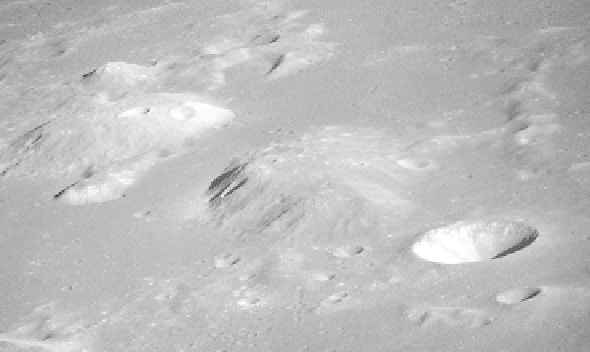Geology Reference
In-Depth Information
basalt samples (
Fig. 4.20(a)
) are quite vesicular, attest-
ing to the high gas content of the lavas in some areas.
their origin as secondary impact craters and suggests a
volcanic origin probably similar to that of collapse-pit
craters.
While not strictly volcanic constructs, several areas of
the Moon are centers of extensive volcanism. For exam-
ple, the Aristarchus Plateau (
Fig. 4.31
), the source of
Schröter
'
s Valley, displays spectral signatures indicative
of a variety of basaltic lavas and pyroclastic deposits
and is probably one of the largest volcanic centers on
the lunar near side. Similarly, the Harbinger Mountains
are the source region for numerous large sinuous rilles
(
Fig. 4.40
). Recent analysis of LRO altimetry by Paul
Spudis et al.(
2011
) of the Lunar and Planetary Institute
suggests that some of the volcanic centers, such as the
Marius Hills and the Mayer-Hortensius dome west of
Copernicus crater, could be very large shield-like volca-
noes that lack central calderas.
4.5.5 Volcanic constructs
Although the Moon lacks large classic shield volcanoes
and composite cones, it does show evidence of several
styles of
volcanism in the forms of domes, small
shield volcanoes, and cones. For example, the Marius
Hills (
Fig. 4.9
) represent more than 200 domes that have
been identi
ed on mare surfaces. Such mare domes range
in diameter from 2 to 25 km and can be as high as 300 m.
Their association with sinuous rilles would suggest basal-
tic compositions.
In contrast to the Marius Hills, the steeper slopes of the
Gruithuisen domes (
Fig. 4.36
) appear to re
ect the erup-
tion of lavas with rheological properties more akin to
those of silicic magmas than to those of basalts, as postu-
lated by Lionel Wilson and Jim Head. For example, the
Gruithuisen domes are as large as 20 km across and stand
a kilometer high, suggesting formation from extrusion of
viscous lavas.
Small shield volcanoes, called low shields because of
their small height-to-diameter aspect ratio (~0.008 com-
pared with 0.03 for Hawaiian shield volcanoes), have
been identi
ed in the mare deposits of the Orientale basin
(
Fig. 4.37
). These features are only about 10 km across and
are similar to features seen on Earth, Mars, and Venus.
In a few areas of the Moon (
Fig. 4.38
), rows of small
cones aligned on inferred
ssures are thought to be spatter
cones, formed by the ejection of clots of pasty lava. Other
aligned features include the much larger rimless craters of
the Hyginus Rille (
Fig. 4.39
); the occurrence of rimless
craters within a linear rille (a probable graben) precludes
“
central
”
4.5.6 Tectonic features
Most tectonic features on the Moon appear to be associated
with crustal adjustments in response to large impacts or
adjustments of mare deposits within basins. For example,
the Alpine Valley (
Fig. 4.41
) is 10 km wide and 150 km
long, and is oriented radially to the Imbrium basin. Linear
rilles, such as Rima Ariadaeus (
Fig. 2.9
), are grabens that
cut across highlands, maria, and existing impact craters,
reflecting deep-seated tectonic deformation of the crust.
Careful mapping of the relative ages of sets of grabens on
the Moon suggests that they post-date the emplacement of
most maria and appear to represent reactivation of struc-
tures associated with impact basins.
Floor-fractured craters are large impacts with floors
that have been extensively modi
ed (
Fig. 4.42(a)
). Studies
Figure 4.36. An oblique view of the Gruithuisen domes,
obtained by the Apollo 15 astronauts. These non-mare
domes are thought to represent non-basaltic volcanism
(NASA AS I5
-
93
-
12711).



